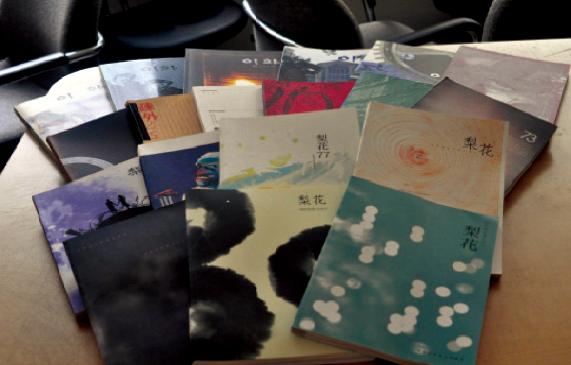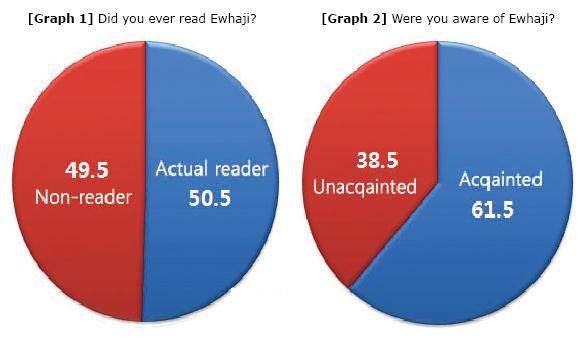Ewhaji reaches for scattered voice of Ewha students
Students chatting and enjoying kimbap at the crowded Ewha Sarang; Students hurrying up to their classes before professors arrive. Yes ladies, the semester has begun. Editors of the Ewhaji now quietly put a full stop to the end of the long summer, ready to present the results of their hard work, a 200-page publication containing the perspective of Ewha students all of which is optionally paid for by a 2,000 won fee included in tuition.

Gyoji, one of a kind school magazine
Ewha has never been dormant during the summer vacation; among those keeping busy are the perspiring reporters of Ewhaji who run around campus creating their magazine filled with Ewha students’ threads of thought.
“There is no such thing as summer vacation to Ewhaji,” Beom Ji-yoon (Molecular Science, 2), a reporter for Ewhaji said. “We devote our entire summer to our work.”
Most universities have their own gyoji, a Korean word for a university school magazine which publishes students’ literary works or other artistic pieces and articles. The characteristic of each gyoji varies from university to university.
However, they all share a common point; they are independent media run solely by students who value the opportunity to voice their opinions.
“Unlike other existing mass media, gyoji has nothing to do with making a profit. In that, we can be more objective to issues when we deal with issues inside and outside campus,” said Gyu won (Seoul National University, 2), the current editor-in-chief of Kwanak, Seoul National University’s gyoji. “Also, as students who have just become adults, we can see issues from a more fresh and creative perspective.”
The fact that gyoji gets support from and is directed by students themselves is significant. Gyoji has more liberty to publish students’ opinion, thus creating both an advantage and an attack point for authorities.
“Basically, we think that gyoji should serve the main purpose of media which is to monitor the authority and to represent the voices of the minority,” said Park Ji-hoon (Yonsei University, 4), a reporter for Yonsei University’s gyoji. “I think a gyoji can deal with anything that is related with university students from campus news to the rights of school workers we see every day.”

How Ewhaji collects students’ voice
Ewha’s own independent media, Ewhaji (which is a combination of the name Ewha and the word gyoji) was first published in 1929. Ewhaji’s history flows with Korea’s history; from its inception through the following decade, Ewhaji was primarily a literary work for Ewha students.
In the 1940s, the publication of Ewhaji was prohibited due to Japan’s censorship after the Japan-Korea Annexation Treaty. Students republished Ewhaji in 1950, and covered issues around campus and in society. Now Ewhaji is published twice a year. Ewhaji reporters pass out magazines to Ewha students on Monday mornings, when chapel begins for the semester.
“A truck full of Ewhaji arrives at campus around 7:30 a.m. and we are also there to meet as many Ewha students as possible.” Oh Hae-seong (Environmental Science, 3), a senior reporter for Ewhaji said.
The process of planning, writing and distribution starts from an editorial meeting during the semester.
“Every reporter brings three to four items based on its timeliness and proximity,” reporter Park Shin-young (French literature, 2) said.
“We try to gather almost every Ewha students’ opinion since they are Ewhaji’s only supporters,” reporter Beom said. “Therefore we weigh Ewha students’ interest during the meeting.”
After fierce debates regarding next issue’s topics, reporters rush to dig up the issue during the summer vacation. Two to four stories are allotted to each reporter on average. Two weeks before the start of a semester, Ewhaji reporters become Ewhaji editors and designers at the same time.
No byline, one consent
One marked feature of Ewhaji is the absence of reporters’ bylines. The Editorial Office of Ewhaji decided to publish every article under the name of the office instead.
“What we publish is on behalf of Ewha students and we want to shoulder the responsibility of posting an article together,” reporter Park said.
However, the concept of one byline for all stories results in Ewhaji’s publishing maxim: unanimous consent on writing issues. The word “fierce debate” itself surely fits Ewhaji’s editorial meetings.
“Reporters try to persuade each other of the value of a specific topic during the meetings. Sometimes we fight and the meeting takes a long time,” Oh said. “Reporters are usually like family, but controversy sometimes leads to arguments. We eventually end up broadening the story’s perspective, which is good for Ewha students.”
Besides internal debates within Ewhaji, outside intervention is also inevitable for gyoji journalism. Although Ewhaji is only supported by each Ewha student paying 2000 won, the school’s indirect censorship can suppress Ewhaji, prohibiting it from publishing certain ideas or issues.
“Criticizing the school’s agenda or events is sensitive but after all, it also represents Ewha students’ voice,” reporter Kang Mi-young (Business, 2) said.
The scarcity of Ewha students’ support, other than financially, is also another problem faced by the publication.
“Active feedback, as in old times, will bestow more power to Ewhaji. I wish Ewha students’ debate on social, campus and women’s issues to be more progressive,” Oh said.
Survey report: Ewha students’ interests and awarness of Ewhaji
The Ewha Voice conducted a survey of 200 Ewha students concerning their interests and awareness of Ewhaji.
The results showed that first of all, the recognition of Ewhaji was comparatively high but the percentage of people who actually read it was low.
Among the 200 students, more than 61.5 percent heard of Ewhaji while 38.5 percent had not. On the other hand, the percentage of readers was slightly higher than 50 percent, indicating that there are students who recognize Ewhaji but do not read it. Also, the higher the grade, the more students knew about the existence of Ewhaji.
The biggest reason why students do not know about Ewhaji at all is because of hidden kiosques. More than 40 percent respondents answered that they did not read the Ewhaji because they rarely found it on campus.
One of the most unique characteristic of Ewhaji is that it is solely produced with 2,000 won fee in every student’s tuition, but the figure from the survey showed that more than 65 percent are not aware of this fact. While more than 80 percent of freshmen and 70 percent of sophomores were unaware of the fee, juniors and seniors tended to be more acquainted with Ewhaji.
What students want and what students need in Ewhaji
The Ewha Voice inquired to what extent Ewhaji is satisfying its readers. Regarding the quality of Ewhaji, 44.6 percent of readers answered that they considered the publication “mediocre,” while 42.6 percent of students said they were satisfied with it. Regarding the contents of Ewhaji, 42.5 percent of the respondents were satisfied with the overall contents, while a quarter of them wanted Ewhaji to become a literary magazine.
About 85 percent students responded that raising awareness of the publication is a top priority for Ewhaji to create more active communication with Ewha students. Others suggested that Ewhaji should deal with more interesting stories, such as daily life subjects on campus, student editorials, and draw students’ participation through surveys and interviews, use color prints, and introduce school events and policies.
“If Ewhaji becomes more sensitive toward the readers’ requests and suggestions, it will definitely be a better school paper,” Choi Se-rim (Computer Information Communication, 1) said.

